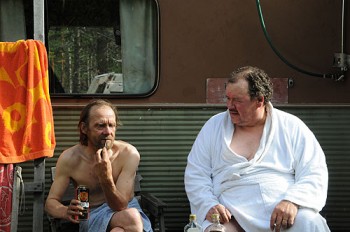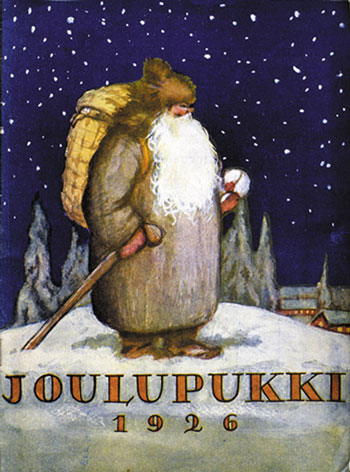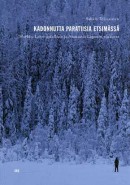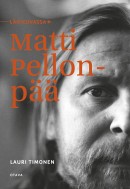Tag: cinema
The many arms of Krishna
14 August 2014 | Extracts, Non-fiction

A feast by the Ganges. Photo from Pirjo Honkasalo’s film Atman
Cinematographer, camerawoman and director Pirjo Honkasalo has travelled and filmed widely – Japan, Estonia, India, Chechnya, Ingushetia, Russia – and her documentary films in particular have gained fame. American film critic John Anderson interviews Honkasalo; they talk about her documentary film Atman (1996) about a pilgrimage in India.
Edited extracts from Armoton kauneus. Pirjo Honkasalon elokuvataide (‘Merciless beauty. The film art of Pirjo Honkasalo’, Siltala, 2014; translated from English into Finnish by Leena Tamminen)
You can almost catch a whiff of the Ganges watching Atman [Hindu term, ‘self’], a documentary film in which religious pilgrimage, devotion, exhilaration and hysteria compete with tormented bodies, physical mortification, corpses, pollution and the acrid smoke of ritual cremation for domination of the viewer’s senses. The fact that it won the top prize at the International Documentary Film Festival Amsterdam in 1996 proves there is, if not justice, then good taste in the world. With all due respect to her previous work, Atman signified the full manifestation of Honkasalo’s genius.
What is it about? Eternity. Also, Jamana Lal: a member of the low-caste of Baila, a wifeless, crippled devotee of Lord Shiva whose mother has died, and who must – according to Hindu tradition – take her ashes from the ostensible mouth of the Ganges to the foothills of the Himalayas. More…
Peter von Bagh: Junassa [On the train]
26 August 2011 | Mini reviews, Reviews
 Peter von Bagh
Peter von Bagh
Junassa
[On the train]
Helsinki: Love Kirjat / WSOY, 2011. 255 p., ill.
ISBN 978-951-0-37921-9
€18, hardback
Professor Peter von Bagh, a film director and academic, is the author of a wide range of books on the history of film and culture. In this small-scale volume of essays, he investigates the significant role played by trains and railways in cinematic plot structures since the days of silent film. The text chugs along in a series of snippets, reminiscent of a rail passenger’s experience of scenery zipping past. This book looks at classics of the film noir, Western and romance genres, along with films that have used trains as a deeper metaphor for life. von Bagh also considers the critically derided but widely loved Finnish popular culture from the 1940s and ’50s, as well as fiction. For example, author Juhani Aho’s first novel, Rautatie (‘The railway’, 1884), depicted an individual’s first experience of a train journey with a degree of authenticity that it can be compared to the uproar the Lumière brothers’ early films generated among the audiences. Unfortunately Junassa lacks an index of the works and people mentioned in the text.
Translated by Ruth Urbom
The naked truth
18 January 2011 | This 'n' that

Out with the truth: sauna camaraderie in the film Steam of Life. Photo: Oktober
Finnish men don’t usually open up about much, it’s generally thought, as they don’t like to speak about feelings.
But in the sauna, it’s different. Intimacies are revealed in its soft steam, by men who sit there quietly and give voice to the sorrows of their lives.
In Miesten vuoro / Steam of Life, a full-length documentary film by two directors, Joonas Berghäll and Mika Hotakainen which premiered in March 2010, Finnish men both talk and weep. They have gained considerable popularity among audiences in Finland and abroad.
A naked guy sits on a wooden bench in the steam or outside the sauna building (which could be an old wooden hut in the countryside, a modern city sauna or some odd construction serving the purpose) with a bottle of beer in his hand, and tells the man sitting next to him in earnest about his dead child, new wife, or the death of his mother: the great sorrows or joys of his life.
Water, fire, bare skin and no ornaments: vulnerability. He can be a war veteran or a younger man, lonely or happily married. But he talks, cleansing himself both physically and mentally.
Steam of Life has so far been seen by approximately 50,000 people in Finland, and the DVD has sold more than 28,000 copies. It is the first Finnish documentary to compete for the Academy Award for Best Foreign Language Film. The Oscar nominees will be published on 25 January, with the award ceremony taking place at the end of February.
Steam of Life has won prizes both in Finland and abroad: in Tel Aviv, Warsaw, Pärnu in Estonia, Germany (DOK Leipzig where it won a Silver Dove) and Portugal. It received a Special Jury Mention at the Silverdocs documentary film festival in the United Sates and the Prize of the Interreligious Jury at the Visions du Réel festival in Switzerland. It will continue its tour of film festivals this year; see the trailer here.
The DOK Leipzig jury commented: ‘The film, deliberately set in an original Finnish situation – a sauna, opens a door into the intimate and hidden world of men’s fragility and vulnerability, turning the sauna into a place where naked truth is told by naked men. The film bends together tragic and comic….’
Mies ei puhu eikä pussaa is a saying; we’d translate this as ‘a Finn neither speaks nor snogs’, Finn referring to a male person. But the times, they are a-changing, it seems.
Ho-ho-no!
10 December 2010 | This 'n' that

In the olden days: Father Christmas dressed in grey. A Christmas magazine illustration, 1926. Picture: Helsinki City Museum
St Nicholas, Father Christmas, Santa Claus? According to Finns, the benevolent, bearded, reindeer-driving, present-giving figure lives on Korvatunturi fell in Lapland (not at the North Pole, not anywhere else!).
In Finnish his name is Joulupukki, ‘Yule goat’ (or ‘buck’, Old English, bucca). Joulupukki developed from pagan traditions where his predecessor was a creature called Nuuttipukki, ‘Knut’s goat’, which referred to St Knut’s day, originally on 7 January.
The end of Christmas was celebrated by itinerant groups of people visiting houses playing for food and, in particular, booze. Leading them was the scary ‘Knut’s goat’ disguised in horns, a face mask and lambskins, frightening children. If he wasn’t given beer, he could steal the spigot from the beer barrel or beat people with a bunch of twigs.
This tradition was popular until the beginning of the 20th century, when the good Joulupukki replaced his old bad post-Christmas counterpart, shedding his horns and mask. However, when he came to people’s homes on Christmas Eve to bring presents, he still wore a fur coat, was heavily bearded and might still carry both twigs and gifts – so children had indeed better watch out how they behaved all year.
Naughty or nice? A new full-length Finnish film directed by Jalmari Helander entitled Rare Exports: A Christmas Tale was released internationally in early December.
In this Yuletide film the central figure of the mundane Christmas celebrations is not the red-dressed, jolly Santa we know, but ‘a sinister old codger who chews off ears and whose demon minion kidnaps innocent children. Ho ho no!’, as Jeannette Catsoulis reported in the New York Times.
‘Rare Exports is an enormously entertaining and unpredictable Yuletide romp packed with sly wit, solid scares and naked geriatrics,’ said Tom Huddleston of Time Out London.
Frank Lovece, in Film Journal International, wrote: ‘Some human and reindeer gore make this inappropriate for young children, as much as the movie’s boy-hero denouement may suggest otherwise. But for anyone who needs an inoculation of humbug to counter artificial sentiment, or who simply likes to smoke their Christmas cheer or put it in brownies, this off-kilter return to roots is a welcome gift.’
The plot involves a mysterious block of ice that has been unearthed in Lapland, sprouting a pair of horns. Children begin to disappear, reindeer are found killed. A ten-year-old boy finds out what’s happening, and he and his dad take up fighting back. ‘Wicked fun in the manner of a 21st century Grimm’s fairy-tale,’ said Chris Barsanti of filmcritic.com. ‘Exuberantly pagan images,’ wrote Jeannette Catsoulis.
Well, Rare Exports was in fact filmed in Norway: Finnish fells are low and unimpressive in comparison to the higher Norwegian fells and mountains. Joulupukki’s home on Korvatunturi is particularly difficult to access, as the Russian border cuts through this formation of fells, which is also a part of a nature conservation area.
Santa’s red, fur-lined outfit is a comparatively recent invention, by the way: it became popular in the United States in an advertising campaign for Coca-Cola in 1931. By a trick of fate, though, the image was designed by one Haddon Sundblom who was of Finnish (Åland) origin.
So, what’s the truth about Joulupukki ? Could it be that an incarnation of the ancient horned shaman-like creature might still dwell in the depths of that faraway Lapland fell, and that the Coca-Cola man on whose lap your kid is sitting, listing his or her wishes, is just some commercial impostor?
Peter von Bagh: Sodankylä ikuisesti [Sodankylä forever]
11 June 2010 | Mini reviews, Reviews
 Sodankylä ikuisesti
Sodankylä ikuisesti
[Sodankylä forever]
Helsinki: WSOY, 2010. 308 p., ill.
ISBN 978-951-0-36290-7
€ 52, hardback
The Midnight Sun Film Festival is the world’s northernmost film festival. Held in Sodankylä, Lapland, it is now 25 years old. This scrapbook includes the text of speeches given by filmmakers as well as a wealth of material about the films shown over the years. Much of this material is based on the morning discussion panels which the festival’s director, film historian and author Peter von Bagh, has chaired with his guests. More than one hundred film directors, from Samuel Fuller to Wim Wenders, talk about the background and influences in their work. Von Bagh has constructed dialogues between directors who did not actually attend the same sessions; he calls these conversations – sometimes between the living and the dead – ‘heavenly dialogues’. The Festival was founded by Finnish film directors Aki and Mika Kaurismäki and Anssi Mänttäri in collaboration with the municipality of Sodankylä. The light summer nights and laid-back atmosphere at the festival delight the speakers and audience members every year. In the words of the American filmmaker D.A. Pennebaker, ‘Woodstock is fuckin’ nothing if you’ve been at the Midnight Sun Film Festival.’
Sakari Toiviainen: Kadonnutta paratiisia etsimässä [In search of a lost paradise]
12 August 2009 | Mini reviews, Reviews
 Kadonnutta paratiisia etsimässä. Markku Lehmuskallion ja Anastasia Lapsuin
Kadonnutta paratiisia etsimässä. Markku Lehmuskallion ja Anastasia Lapsuin
elokuvat
[In search of a lost paradise. The films of Lehmuskallio and Anastasia Lapsui]
Helsinki: Finnish Literature Society, 2009. 274 p., ill.
ISBN 978-952-222-067-7
€ 28, paperback
Markku Lehmuskallio (born 1938) is a filmmaker and photographer who since 1973 has made 18 full-length feature films, as well as a number of shorter ones. A half of his work is a collaborative venture with his wife Anastasia Lapsui, who is a native of the Nenets region in Arctic Russia. The main subjects of his films are the relationship between people and nature, and indigenous cultures throughout the northern hemisphere. Lehmuskallio’s early work reflects his activity as a pioneer of the green movement, as his films from that period deal with the environmental threat to the forests. Lehmuskallio has also directed fiction films, including the first to be made in the Nenets language, the award-winning Seven songs from the tundra. He has documented the conflicts between indigenous and national cultures, such as the destruction of the environment of the Siberian peoples in the process of gas and oilfield exploration. The filmographer Sakari Toiviainen had access to original material ranging from brittle old reels of film to diaries; Lehmuskallio’s own voice comes through clearly in the text.
Lauri Timonen: Lähikuvassa Matti Pellonpää [Matti Pellonpää in closeup]
16 July 2009 | Mini reviews, Reviews
 Lähikuvassa Matti Pellonpää
Lähikuvassa Matti Pellonpää
[Matti Pellonpää in close-up]
Helsinki: Otava, 2009. 335 p., ill.
ISBN 978-951-1-22903-2
€ 25, hardback
Matti Pellonpää (1951–1995) was one of the trusted actors, almost a trademark, of the film director Aki Kaurismäki. In 1993 he won the Felix Prize for best European male actor at the Berlin Film Festival for his role in La Vie de Bohéme. With his characteristic restrained empathy Pellonpää mostly played bohemians, unemployed people and outcasts. This portrait is built on the recollections of his friends and colleagues, as well as on the interviews by the author. These conversations deal with Pellonpää’s theatrical career and the musical experiments of his highly original band, Peltsix. The actor spent most of his free time in restaurants, where he eavesdropped on table talk and watched the eccentric personalities he encountered; the reader is also offered a sample of Pellonpää anecdotes.

